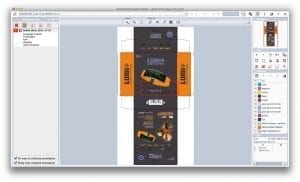“… E-commerce operators are overworked, because they have to constantly check that the attached file is suitable for printing, and many times they cannot even afford to do so at the expense of quality and efficiency…”
Thanks to a fully automated workflow, it is possible to:
- Eliminate errors in the process by presetting the repetitive activities
- Authorise automatic decisions in the workflow
- Increase efficiency and productivity
- Save time and reduce costs thanks to a workflow without an operator, available 24 hours a day, seven days a week.
Pre-press Automation
An automated workflow is the heart of any prepress department.
Prepress automation includes several activities that do not require an operator and for which numerous tasks that usually involve human intervention are carried out: preliminary verification, application of abundances, repetition, adding registration marks, creating reports and even more.
All these activities are linked together in a single workflow. Some require decisions to be made based on predefined parameters.
Other decisions depend instead on the decision of managers and can be held in abeyance until the final definitive approval.
[embedyt] http://www.youtube.com/watch?v=tbnaqbH5QK8[/embedyt]
Assurance of quality
An automated flow contains a viewer that shows the product before sending it to the output device for the production of plates or for printing. An expert can then check the separations, bitmap data, dimensions of the trim and the difference between the original design and the final production files in order to verify that all the corrections have been made.
The automatic comparison tools allow the user to immediately see the changes made. It is possible to interrupt a job until authorisation to proceed is received from a manager.
Integration with Packway
Automation Engine integrates seamlessly with any existing infrastructure. It accepts a wide range of desktop publishing formats, RIP or file server, and supports all industry standards, such as PDF, XML, XMP, SQL queries and JDF/JMF communication.
From the basic version to more elaborate setups, Automation Engine ensures a swift and unequalled return on investment. The Connect module also allows you to connect Automation Engine, WebCenter or ArtiosCAD to a company system that supports the integration – MIS, online stores, financial systems, shipping systems, etc., without the need for custom development.
The integration between Packway and the prepress flow automation system Automation Engine allows the various departments of the company to work in synergy. In this way, errors, delays and inefficiencies in the preparation of print files and nesting are avoidable. It will also optimise the management of process and the control of costs during printing.
The workflows generate perfectly printable dynamic barcodes, offering advanced functionality such as the automatic generation of boxes, reducing the width of the bars and scaling according to resolution of the output. Alternatively, it is possible to create registration marks for the final print.
Creation of Reports and Integration with Structural Data 
The report sheets are based on a predefined template that customises them for a specific job. They use the properties, customer information and details that can be extracted from the database. It is also possible to add metadata such as ink consumption and the specifications of the barcodes.
You can generate 3D PDF files from the structural data associated with the job. Combined with the graphics data, they offer a three-dimensional view of the how the actual finished work will appear. The 3D view can also be integrated into the report sheet.



